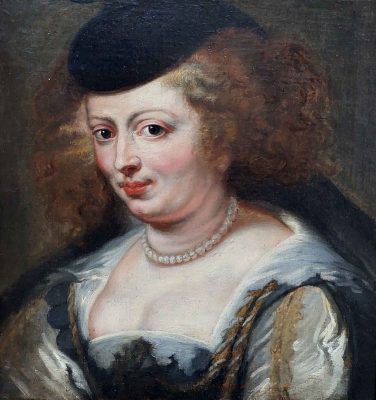15 July 2023 marks the 350th anniversary of the death of Helena Fourment, the second wife of Rubens, who is interred in Saint-James’s Church (Sint-Jacobskerk) in Antwerp. To commemorate this day, a small presentation is held in the Keizerskapel and Saint-James’s Church from 15 July until 3 September 2023. The timeline below illustrates key moments of Helena’s life in Antwerp.
1 April 1614: Helena Fourment, eleventh child of Daniël Fourment and Clara Stappaerts was baptized. Godfather is Willem van Aelst and godmother Helena Stappaerts (from whom she clearly inherits her name). Three months later, on 5 June, Rubens’s second child Albertus (from his marriage with Isabella Brandt) was baptized, having about the same age of his father’s future wife.
When Helena was born, several of her sisters had already married. Johanna (1596-1631), Daniel’s fourth child, with Balthasar de Groote (1583-1656). They lived in what is now called the Delbekehuis in the Keizerstraat in Antwerpen. In front of the mansion of Nicolaes Rockox and only a few steps away from the Keizerskapel (Emperors Chapel), where Balthasar had business-connections.
6 December 1630: Helena and Pieter Paul Rubens married at Saint-James’s Church. The famous Portrait of Helena Fourment (oil on panel, 163,5 x 136,9 cm) in the Alte Pinakothek in Munich pictures Helena in her wedding dress.
10 January 1632: their first child Clara Johanna is baptized at Saint-James’s Church. 12 July 1633: baptism of their second child Frans; next are Isabella Helena (May 3rd 1635) and Peter Paul (2 March 1637), all at Saint-James’s Church. On 10 July 1638, once again at Saint-James’s Church, Helena is the godmother of David III Teniers, son of David II and Anna Breughel (daughter of Jan I Breughel) who lived in the nearby Lange Nieuwstraat. David I Teniers is godfather. 26 January 1639: death of Clara Stappaerts, Helena’s mother (and second mother-in-law of Rubens). She is buried at Saint-James’s Church in the southern ambulatory. Followed on 5 June 1643 by her husband Daniel I Fourment. When Rubens died on 30 May 1640, he was temporarily interred in the Fourment family crypt (until 1645).
3 February 1641: baptism of Constantia Albertina, fifth child of Rubens and Helena, at Saint-James. Probably in 1644: marriage of Helena Fourment with Jan-Baptist de Brouchoven de Bergeyck (1619-1681). Their first child Jan is baptized 9 October 1644 at Saint Andrew’s Church Antwerpen. And one year later Rubens’s coffin is transferred to the crypt of his new built chapel in Saint-James’s Church.
25 March 1656: baptism of Jacob Ignatius van Parys, son of Philip and Clara Johanna Rubens (Helena’s eldest daughter) at Saint-James. Helena is godmother.
On 8 June 1658, Helena declares by will that she wants to be buried in Rubens’s crypt. She adds that Het Pelsken (oil on panel, 176 x 83 cm, 1638) now in the Kunsthistorisches Museum in Vienna cannot be inherited by her husband. In 1665, Jan-Baptist de Brouchoven de Bergeyck is allowed the titel of Baron, making Helena Barones. 28 September 1670: Marie-Fernande de Brouchoven de Bergeyck, daughter of Helena (from her second marriage), refers to her nephew Franciscus-Paulinus de Brouchoven de Bergeyck for an introduction letter he wrote for the benefit of her intention to join a cloister. Franciscus-Paulinus brings us back to the Keizerstaat and the Keizerskapel. Indeed. He was ‘alderman’ in Antwerpen but also ‘godfather’ of the newly cast bell (1671) by Melchior de Haze (1632-1697) at the Keizerskapel (Emperors Chapel), in the presence of Helena.
Finally on 15 July 1673, Helena Fourment dies from a long and unpleasant illness (“par une longue et facheuse maladie”). She is interred on 4 August in the Rubens Chapel at Saint-James’s Church. Widower Jan-Baptist remarries Marie-Françoise d’Ennetières in 1674 and is ennobled Count in 1676.

Text [via codart.nl] by Bruno Aerts and Jean-Pierre de Bruyn